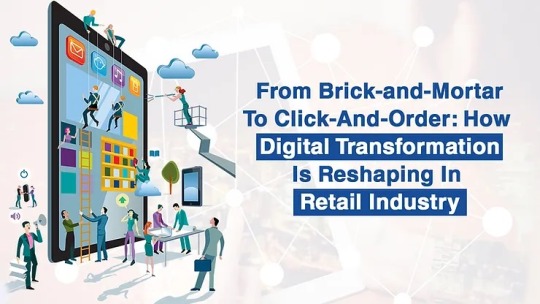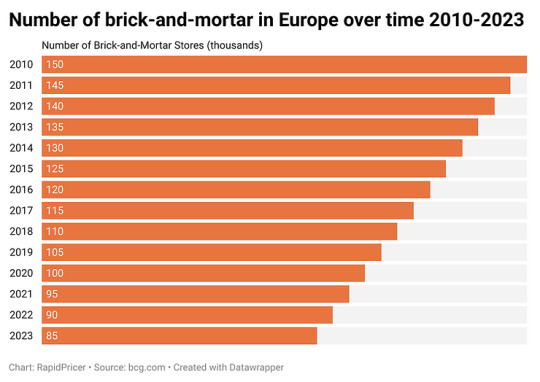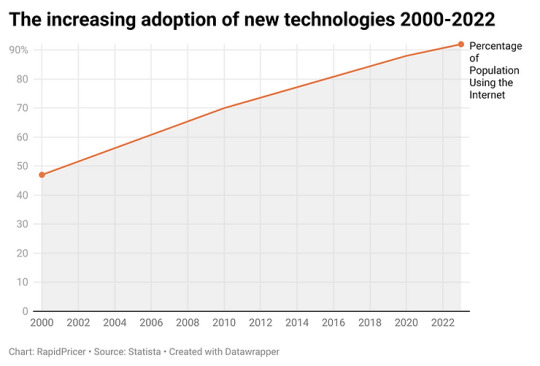#Retail Technology Trends
Text
From Brick-and-Mortar to Click-and-Order: How Digital Transformation is Reshaping Retail Industry

Discover the transformative journey from traditional retail to digital prowess. Explore the profound impact of digital transformation on the retail industry, uncovering enhanced customer experiences, increased efficiency, and broader market reach.
#Retail Tech#Digital Transformation#E-commerce Revolution#Retail Technology Trends#Digital transformation in retail
0 notes
Text
With the waves of emerging technologies, retail industries have become more reliant on them to provide an easy and incredible user experience. Digital transformation, cloud services, networking, etc. are some of the ways retailers are reinventing their stores.
#retail#retail industry#retail software development#technology trends#technology trends for retail industry#top 10 retail technology trends#retail technology trends
0 notes
Text




#Wendy’s#stupid#supply and demand#pricing strategies#consumer behavior#savings tips#happy hour deals#early bird specials#booking tips#off-peak travel#surge pricing#dynamic pricing#variable pricing#real-time pricing#revenue optimization#technological advances#fast food pricing#restaurant pricing#retail pricing#pricing trends
18 notes
·
View notes
Text
How do stores stock just what you need? It's Predictive Analytics at play! By analyzing past purchases, they can forecast future sales, keeping shelves filled with your favorites while cutting down on excess inventory. It's like having a crystal ball for sales! 🛍️
#predictiveanalytics#sales#retail#retail analytics#retail industry#data driven#retail technology#trends#datascience#bigdata#getondata
2 notes
·
View notes
Text
What is the best POS system for Magento/Adobe Commerce in 2023?
The best POS system for Magento/Adobe Commerce in 2023 depends on your specific needs and budget. However, some of the most popular and highly rated options include:
Magestore POS is a comprehensive POS system that offers a wide range of features, including inventory management, customer relationship management (CRM), and loyalty programs. It is also tightly integrated with Magento, making it easy to sync data between your online and offline stores.
ConnectPOS is another popular POS system for Magento/Adobe Commerce. It is known for its ease of use and its wide range of features, including offline mode support, barcode scanning, and gift card processing.
Acid POS is a good choice for businesses that need a robust POS system with advanced features, such as employee management, reporting, and analytics. It is also compatible with a wide range of hardware and payment processors.
Amasty POS is a lightweight POS system that is ideal for small businesses. It is easy to use and offers a variety of essential features, such as inventory management, customer management, and payment processing.
Webkul POS is a versatile POS system that can be used for a variety of businesses, including retail, restaurants, and salons. It offers a wide range of features, including inventory management, customer management, and employee management.
#Magento#AdobeCommerce#POS#ecommerce#retail#restaurant#salon#business#entrepreneur#marketing#sales#customerservice#technology#innovation#trends
2 notes
·
View notes
Text
Digitsole: Pioneering Innovations in the Smart Shoes Market

Introduction:
The smart shoes market is rapidly evolving, driven by advances in technology and increasing consumer demand for integrated, health-focused solutions. Among the key players in this market, Digitsole stands out with its innovative approach and strategic developments that are shaping the future of smart footwear.
This article delves into the strategies, emerging innovations, and developments embraced by Digitsole as it navigates the dynamic landscape of the smart shoes market.
Download Free Sample: https://www.nextmsc.com/smart-shoes-market/request-sample
Strategic Vision
Digitsole's strategy is centered around creating a seamless blend of technology and footwear to enhance the user experience. Their vision is to transform traditional shoes into intelligent devices that offer real-time insights, improve health and fitness, and provide unparalleled comfort. To achieve this, Digitsole focuses on three key strategic pillars: innovation, collaboration, and customer-centricity.
1. Innovation at the Core
Innovation is the cornerstone of Digitsole's strategy. The company invests heavily in research and development to integrate cutting-edge technologies into their products. Their innovations are designed to address the evolving needs of consumers, ranging from fitness enthusiasts to individuals seeking medical support. Key areas of innovation include:
Advanced Sensors: Digitsole shoes are equipped with high-precision sensors that monitor various parameters such as steps taken, calories burned, posture, and gait. These sensors provide accurate data, enabling users to track their health and fitness metrics in real-time.
AI and Machine Learning: By leveraging artificial intelligence and machine learning, Digitsole can offer personalized recommendations to users. This technology helps in analyzing user data and providing insights for improving performance, preventing injuries, and optimizing training routines.
Smart Heating System: One of Digitsole's standout features is its smart heating system, which allows users to adjust the temperature of their shoes via a mobile app. This innovation is particularly beneficial for individuals in colder climates or those with specific medical conditions.
2. Strategic Collaborations
Digitsole recognizes the importance of collaboration in driving growth and expanding market reach. The company has formed strategic partnerships with various stakeholders, including sports brands, healthcare providers, and technology companies. These collaborations enable Digitsole to integrate its technology into a wider range of footwear and enhance its product offerings.
Sports Brands: Collaborating with established sports brands allows Digitsole to leverage their expertise in footwear design and reach a broader audience. By integrating Digitsole's technology into popular sports shoes, they can offer enhanced performance tracking and injury prevention features.
Healthcare Providers: Partnering with healthcare providers enables Digitsole to develop specialized products for individuals with medical needs. Their smart shoes can monitor and analyze gait patterns, providing valuable data for diagnosing and treating conditions such as diabetes, arthritis, and rehabilitation post-surgery.
Technology Companies: Working with technology companies allows Digitsole to stay at the forefront of innovation. These partnerships facilitate the integration of the latest advancements in AI, IoT, and wearable technology into their products.
3. Customer-Centric Approach
Digitsole places a strong emphasis on understanding and meeting the needs of their customers. Their customer-centric approach involves continuous feedback loops, user testing, and a focus on delivering value. By prioritizing user experience, Digitsole ensures that their products are not only technologically advanced but also practical and user-friendly.
Inquire Before Buying: https://www.nextmsc.com/smart-shoes-market/inquire-before-buying
Emerging Innovations
Digitsole's commitment to innovation has led to the development of several groundbreaking products and features that are reshaping the smart shoes market.
1. Biomechanical Analysis
Digitsole's smart shoes are capable of conducting detailed biomechanical analysis. By monitoring and analyzing parameters such as foot pressure, balance, and stride length, these shoes provide users with insights into their walking and running mechanics. This information is invaluable for athletes looking to optimize their performance and for individuals aiming to prevent injuries.
2. Health Monitoring
Beyond fitness tracking, Digitsole's innovations extend to health monitoring. Their smart shoes can detect anomalies in gait that may indicate underlying health issues. For example, changes in walking patterns can be early indicators of conditions like Parkinson's disease or multiple sclerosis. By alerting users and healthcare providers to these changes, Digitsole's technology can facilitate early diagnosis and intervention.
3. Energy Harvesting
One of the most exciting developments from Digitsole is their exploration of energy harvesting technology. This innovation involves capturing and storing energy generated by the user's movements. The harvested energy can then power the sensors and other electronic components of the smart shoes, reducing the need for external charging and enhancing the sustainability of the product.
Market Developments
Digitsole's strategic vision and innovative prowess have positioned them as a leader in the smart shoes market. Several key developments highlight their progress and impact:
1. Market Expansion
Digitsole is expanding its presence in both consumer and professional markets. Their products are gaining traction among fitness enthusiasts, athletes, and healthcare professionals. This expansion is supported by strategic partnerships and collaborations that enhance their product offerings and market reach.
2. Enhanced Product Portfolio
Digitsole continues to diversify its product portfolio to cater to different segments of the market. They offer a range of smart shoes designed for various activities, from running and hiking to everyday wear. Each product is tailored to provide specific benefits, ensuring that Digitsole meets the diverse needs of its customers.
3. Increased Awareness and Adoption
As awareness of the benefits of smart shoes grows, Digitsole is witnessing increased adoption of their products. Consumers are becoming more health-conscious and are seeking innovative solutions to monitor and improve their well-being. Digitsole's marketing efforts and customer education initiatives play a crucial role in driving this adoption.
Conclusion
Digitsole's strategic focus on innovation, collaboration, and customer-centricity has positioned them as a trailblazer in the smart shoes market. Their advanced technologies, strategic partnerships, and commitment to meeting customer needs have set them apart in a competitive landscape.
As they continue to push the boundaries of what is possible in smart footwear, Digitsole is poised to shape the future of the industry and redefine the way we think about shoes.
#smart shoes market#smart wearables#footwear tech#footwear#shoes#smart technology#consumer goods#retail#market research#market trends#innovation#sustainability
0 notes
Text
AI-Powered Software Solutions: Revolutionizing the Tech World
Introduction
Artificial intelligence has found relevance in nearly all sectors, including technology. AI-based software solutions are revolutionizing innovation, efficiency, and growth like never before in multiple industries. In this paper, we will walk through how AI will change the face of technology, its applications, benefits, challenges, and future trends. Read to continue..
#trends#technology#business tech#nvidia drive#science#tech trends#adobe cloud#tech news#science updates#analysis#Software Solutions#TagsAI and employment#AI applications in healthcare#AI for SMEs#AI implementation challenges#AI in cloud computing#AI in cybersecurity#AI in education#AI in everyday life#AI in finance#AI in manufacturing#AI in retail#AI in technology#AI-powered software solutions#artificial intelligence software#benefits of AI software#developing AI solutions#ethics in AI#future trends in AI#revolutionizing tech world
0 notes
Text
Digital Health Market: Revolutionizing Healthcare in the 21st Century
The digital health market is experiencing an unprecedented transformation, fueled by rapid advancements in technology, increasing internet penetration, and the growing demand for innovative healthcare solutions. This article delves into the intricate details of the digital health market, exploring its current landscape, key drivers, emerging trends, and future prospects. As we navigate through this comprehensive overview, we aim to provide valuable insights that can help stakeholders make informed decisions and harness the potential of digital health.
Understanding the Digital Health Market
The digital health market encompasses a broad spectrum of technologies and services designed to improve healthcare delivery, enhance patient outcomes, and reduce costs. These include telemedicine, mobile health (mHealth) applications, wearable devices, health information technology (IT), and personalized medicine.
Key Components of the Digital Health Ecosystem
Telemedicine: Telemedicine involves the remote diagnosis and treatment of patients through telecommunications technology. It enables healthcare providers to deliver care to patients in remote or underserved areas, reducing the need for physical visits and enhancing access to medical expertise.
Mobile Health (mHealth): mHealth refers to the use of mobile devices, such as smartphones and tablets, to support health and wellness. This includes health apps for monitoring vital signs, medication adherence, fitness tracking, and chronic disease management.
Wearable Devices: Wearable health devices, such as smartwatches and fitness trackers, collect real-time data on various health metrics, including heart rate, activity levels, sleep patterns, and more. These devices empower individuals to take proactive steps towards maintaining their health.
Health Information Technology (IT): Health IT encompasses electronic health records (EHRs), health information exchanges (HIEs), and other digital tools that facilitate the secure sharing and analysis of health data. This improves care coordination, reduces medical errors, and enhances patient safety.
Personalized Medicine: Personalized medicine leverages genetic and molecular data to tailor medical treatments to individual patients. This approach promises more effective and targeted therapies, minimizing adverse effects and improving patient outcomes.
Driving Forces Behind the Digital Health Market Growth
Several factors are propelling the growth of the digital health market:
Technological Advancements: Innovations in artificial intelligence (AI), big data analytics, blockchain, and the Internet of Things (IoT) are revolutionizing digital health. These technologies enable the development of sophisticated diagnostic tools, predictive analytics, and secure health data management systems.
Rising Healthcare Costs: The escalating costs of healthcare services are driving the adoption of digital health solutions that can improve efficiency, reduce waste, and lower expenses. Telemedicine, for example, can significantly cut costs associated with in-person visits.
Aging Population: The global aging population is leading to an increased prevalence of chronic diseases and a higher demand for healthcare services. Digital health technologies offer innovative ways to manage chronic conditions and support elderly care.
Consumer Demand for Convenience: Patients are increasingly seeking convenient and accessible healthcare options. Digital health solutions, such as telehealth and mHealth apps, cater to this demand by providing on-the-go access to medical advice and services.
Government Initiatives and Policies: Governments worldwide are promoting the adoption of digital health technologies through funding, incentives, and regulatory support. These initiatives aim to improve healthcare accessibility, quality, and sustainability.
Emerging Trends in the Digital Health Market
The digital health market is evolving rapidly, with several key trends shaping its future:
Artificial Intelligence and Machine Learning: AI and machine learning are transforming digital health by enabling predictive analytics, automated diagnosis, and personalized treatment plans. AI-powered chatbots and virtual health assistants are also enhancing patient engagement and support.
Telehealth Expansion: The COVID-19 pandemic has accelerated the adoption of telehealth services, leading to a permanent shift in how healthcare is delivered. Telehealth platforms are expanding their capabilities to include virtual consultations, remote monitoring, and telepharmacy services.
Integration of Wearables with Health IT: The integration of wearable devices with health IT systems allows for continuous monitoring of patients' health and seamless sharing of data with healthcare providers. This integration enhances preventive care and early intervention.
Blockchain for Health Data Security: Blockchain technology is being explored to enhance the security and privacy of health data. Its decentralized and immutable nature ensures secure and transparent data transactions, reducing the risk of data breaches.
Patient-Centric Healthcare: The shift towards patient-centric healthcare emphasizes the importance of patient engagement, empowerment, and personalized care. Digital health solutions are enabling patients to take an active role in managing their health and making informed decisions.
Challenges and Opportunities in the Digital Health Market
While the digital health market presents numerous opportunities, it also faces several challenges:
Data Privacy and Security: The increasing digitization of health data raises concerns about privacy and security. Ensuring robust data protection measures and compliance with regulations, such as HIPAA and GDPR, is critical.
Interoperability: The lack of interoperability between different digital health systems can hinder the seamless exchange of health data. Efforts to establish common standards and protocols are essential to overcome this barrier.
Regulatory Hurdles: Navigating the complex regulatory landscape of digital health can be challenging for companies. Clear and consistent regulatory frameworks are needed to facilitate innovation and ensure patient safety.
Digital Divide: Disparities in access to digital health technologies persist, particularly in low-income and rural areas. Bridging the digital divide is crucial to ensure equitable access to healthcare services.
Adoption and Usability: Ensuring that digital health solutions are user-friendly and meet the needs of both patients and healthcare providers is vital for widespread adoption. Continuous user feedback and iterative design improvements are key to success.
Future Outlook of the Digital Health Market
The future of the digital health market looks promising, with continued growth and innovation on the horizon. Key areas of focus include:
Advanced Analytics and Personalized Care: The use of advanced analytics and AI will further enhance personalized care, enabling precise diagnostics and tailored treatments based on individual health profiles.
Expansion of Telehealth Services: Telehealth will continue to expand, integrating with other digital health technologies to provide comprehensive and coordinated care. Virtual reality (VR) and augmented reality (AR) may also play a role in future telehealth applications.
Enhanced Remote Monitoring: Remote monitoring technologies will evolve to offer more sophisticated and accurate health tracking. This will be particularly beneficial for managing chronic conditions and post-acute care.
Global Collaboration and Partnerships: Collaboration between healthcare providers, technology companies, and governments will drive innovation and the adoption of digital health solutions. Public-private partnerships and international cooperation will be key to addressing global health challenges.
Sustainable Healthcare Models: Digital health technologies will contribute to the development of sustainable healthcare models that prioritize preventive care, efficient resource utilization, and improved patient outcomes.
The digital health market is set to revolutionize healthcare, offering innovative solutions that enhance accessibility, efficiency, and quality of care. By embracing these technologies and addressing the associated challenges, we can pave the way for a healthier future.
#Generative AI#AI market growth#applications of generative AI#AI in healthcare#AI in finance#AI in entertainment#AI in retail#ethical AI#future of AI#AI technology trends
0 notes
Text

Industrial Property Market Analysis
Stay ahead of the curve in the competitive commercial real estate market in Atlanta with insights from Stratus Property Group. Our industry expertise and local knowledge ensure you make informed decisions!
#https://stratuspg.com/portfolio/#atlanta commercial real estate market#atlanta commercial real estate#commercial real estate market#commercial real estate#commercial real estate in atlanta#commercial properties#atlanta commercial properties#commercial real estate market in atlanta#atlanta business opportunities#atlanta economic growth#atlanta commercial real estate trends#atlanta office space#atlanta warehouse properties#atlanta business support#commercial real estate trends#real estate investment strategies#property management tips#office space leasing#retail space development#multifamily property investment#commercial real estate financing options#industrial property market analysis#commercial real estate technology#Property Service#Stratus Property Group#stratuspg#stratuspg.com
0 notes
Text
Offer Overload: Sorting Through Online Shopping Promotions for the Best Deals of Recent Times
The world of online purchasing offers a wide range of options for finding great deals in the current digital era. Every day, promotional offers that range from right-away discounts to rewards schemes show up in our social media feeds and email inboxes. While having so many options is great, it can be challenging to choose through the sea of promotions to find the best deals. So, how can you correctly manage the offer deluge and take advantage of online shopping promotions? Let's breakdown it:

Decide on Your Targets:
Before falling into the world of online purchasing, you should know what you're looking for. Are you looking for particular products, or are you willing to try other deals? Setting priorities can help you stay focused amidst the constant arrival of promotions.
Comparing Shopping:
Avoid paying for the first offer you see. Take the time to compare pricing on other websites and platforms. Use price comparison tools and browser extensions to verify you are receiving the greatest bargain possible.
Subscribe to Newsletters:
If it feels like it is already overflowing with sales emails, it can be useful to sign up for newsletters from your favorite stores. A lot of businesses provide subscribers with access to special offers and discounts, so you can take advantage of savings that others may not be able to.
Follow on social media:
Social media platforms are great for keeping in touch with loved ones as well as learning about the newest deals offered by your favorite companies. Businesses can be connected on social media sites like Twitter and Instagram, where they frequently share about quick deals and special discounts.
Make use of reward programs:
A lot of internet businesses offer reward schemes that give regular customers access to special discounts, free delivery, and other benefits. Utilize these offers to get the most out of your savings and improve your shopping experience.
Give Care to Time:
When it comes to online shopping promotions, timing is everything. Be alert for weekends such as Black Friday and Cyber Sunday, as well as limited-time offers and holiday discounts. Making your purchases during these periods can save you a lot of money.
Conclusion:
A smart approach is necessary for understanding online shopping offers in an age of unlimited offers. Through price comparison, explaining priorities, using reward programs, using social media and newsletters, and being timing-aware, you may sort through the stream of offers and find the best deals that have appeared recently. In order to make the most of your online shopping experience, keep these pointers in mind the next time you're attracted by an excellent offer. Congratulations on your online purchasing,Check our product www.clickere.in
#Augmented Reality#Digital Transformation#Ethical Shopping#Mobile Commerce#Retail Trends#Social Commerce#Sustainability#Technology Trends#Virtual Reality
0 notes
Text
What Is Consumer Research: Methods, Types, Scope & Examples
Explore the world of consumer research with our comprehensive blog. Learn about various research methods, types, and the broad scope of consumer studies. Dive into real-world examples to understand how consumer research impacts businesses and shapes the market landscape. Elevate your knowledge and stay ahead in the dynamic field of consumer insights.
#Consumer research methods#Types of consumer research#Scope of consumer studies#Consumer research examples#Quantitative research in consumer studies#Qualitative approaches in consumer research#Ethical considerations in consumer studies#Consumer behavior analysis#Market research techniques#Demographic analysis in consumer research#Psychographic research methods#Consumer insight generation#Brand perception research#Product testing in consumer studies#Comparative consumer analysis#Cross-cultural consumer research#Technology in consumer studies#Future trends in consumer research#Data-driven consumer insights#Consumer decision-making models#Survey methods in consumer research#Focus group dynamics#Case studies in consumer research#Consumer satisfaction measurement#Trend analysis in consumer studies#Retail environment studies#Consumer feedback and reviews#Online consumer behavior#Social media impact on consumer research#Global consumer trends
0 notes
Text
Maximizing Retail Profits: Harnessing B2B Price Optimization Software
In the ever-evolving world of retail and e-commerce, businesses are constantly seeking ways to gain a competitive edge. Among the many strategies employed, B2B Price Optimization and Management Software stands out as a game-changer. Price optimisation and management (PO&M) software solutions enable businesses to oversee and optimize the prices of their goods and services. These services also provide a growing range of sales intelligence advice, such as best-next-action suggestions and customer churn warnings. In the industry, vendors either focus on back-office price management and product management roles, or they focus on providing real-time sales intelligence to sales representatives and B2B digital commerce websites, or both. Quadrant Knowledge Solutions, a leading global advisory and consulting firm, has recognized the significance of this technology in their report, “B2B Price Optimization and Management Applications, 2023”. Quadrant Knowledge Solutions focuses on helping clients in achieving business transformation goals with Strategic Business, and Growth Advisory Services.
Download the sample report of Market Share: B2B Price Optimization and Management Software
Understanding the Retail and E-commerce Landscape
The retail and e-commerce industry is a highly dynamic and competitive space. Companies within this domain face the continuous challenge of pricing their products right to maximize profitability while staying attractive to their customers. In this context, pricing becomes a critical element of their strategy. Let's delve into some of these challenges:
Rapidly Changing Market Dynamics: Retail and e-commerce markets are highly volatile, with ever-shifting consumer preferences and market trends. Adapting to these changes in real-time is essential to stay competitive. Without the right tools, businesses risk making pricing decisions that are out of sync with market realities.
Intense Competition: In retail and e-commerce, competition is fierce. With numerous players offering similar products or services, pricing becomes a key differentiator. Setting prices too high can drive customers away, while pricing too low can erode profit margins.
Complex Supply Chain and Cost Structures: The retail and e-commerce sector often deals with complex supply chain operations and cost structures. Understanding the true costs associated with a product or service is essential for setting optimal prices. Traditional methods of cost calculation can be time-consuming and error-prone.
Customer Behaviour and Expectations: Today's consumers are more informed and price-sensitive than ever before. Their buying behaviour can change rapidly in response to various factors, including promotions, discounts, and market trends. Retailers must be agile in responding to these changes.
Competitor Pricing Strategies: Keeping a constant eye on competitor pricing is crucial. Businesses need to respond promptly to pricing moves made by competitors to remain competitive. Manual tracking and analysis of competitor pricing are arduous and inefficient processes.
Download the sample report of Market Forecast: B2B Price Optimization and Management Software
B2B Price Optimization and Management Software: A Necessity
B2B Price Optimization and Management Software is the solution to these challenges. This technology leverages advanced algorithms, data analytics, and real-time market insights to help businesses make data-driven pricing decisions. It empowers retail and e-commerce companies to optimize their prices efficiently while taking into account factors like demand fluctuations, competitor pricing, and customer behaviour.
Talk To Analyst: https://quadrant-solutions.com/talk-to-analyst
#In the ever-evolving world of retail and e-commerce#businesses are constantly seeking ways to gain a competitive edge. Among the many strategies employed#B2B Price Optimization and Management Software stands out as a game-changer. Price optimisation and management (PO&M) software solutions en#such as best-next-action suggestions and customer churn warnings. In the industry#vendors either focus on back-office price management and product management roles#or they focus on providing real-time sales intelligence to sales representatives and B2B digital commerce websites#or both. Quadrant Knowledge Solutions#a leading global advisory and consulting firm#has recognized the significance of this technology in their report#“B2B Price Optimization and Management Applications#2023”. Quadrant Knowledge Solutions focuses on helping clients in achieving business transformation goals with Strategic Business#and Growth Advisory Services.#Download the sample report of Market Share: B2B Price Optimization and Management Software#Understanding the Retail and E-commerce Landscape#The retail and e-commerce industry is a highly dynamic and competitive space. Companies within this domain face the continuous challenge of#pricing becomes a critical element of their strategy. Let's delve into some of these challenges:#Rapidly Changing Market Dynamics: Retail and e-commerce markets are highly volatile#with ever-shifting consumer preferences and market trends. Adapting to these changes in real-time is essential to stay competitive. Without#businesses risk making pricing decisions that are out of sync with market realities.#Intense Competition: In retail and e-commerce#competition is fierce. With numerous players offering similar products or services#pricing becomes a key differentiator. Setting prices too high can drive customers away#while pricing too low can erode profit margins.#Complex Supply Chain and Cost Structures: The retail and e-commerce sector often deals with complex supply chain operations and cost struct#Customer Behaviour and Expectations: Today's consumers are more informed and price-sensitive than ever before. Their buying behaviour can c#including promotions#discounts#and market trends. Retailers must be agile in responding to these changes.#Competitor Pricing Strategies: Keeping a constant eye on competitor pricing is crucial. Businesses need to respond promptly to pricing move#Download the sample report of Market Forecast: B2B Price Optimization and Management Software
0 notes
Text
All You Need to Know About Sodium Bromide
Sodium bromide is the most demanded derivative of bromine. It is white-colored, highly volatile, crystalline solid similar to common salt. This salt is used for the use of the bromide radical. There are many applications of the same, just as the other derivatives of Bromine in the drug industry.
Some chemical compounds are called chlorides, halides, and iodides also get extracted while…
View On WordPress
#global market outlook#innovative designs#Market dynamics#market growth factors#market trends#research and development#retail applications#see-through display technologies#Transparent Display Market
0 notes
Text
Changing Landscape of European Retail
Written By: Jagriti Shahi

Figure: Growth of retail in Europe
The retail industry in Europe has undergone significant transformations in recent years, driven by changing consumer preferences, technological advancements, and global economic shifts. From traditional brick-and-mortar stores to e-commerce giants, European retail has seen a remarkable evolution. In this article, we will explore the key trends shaping the changing landscape of European retail and how businesses are adapting to stay competitive in this dynamic environment. The retail sector in Europe is the largest in the world, with a turnover of over €2 trillion in 2021. The sector employs over 20 million people and accounts for about 10% of the EU's GDP. The retail sector in Europe is highly fragmented, with a large number of small and medium-sized enterprises (SMEs). However, there are also a number of large multinational retailers operating in the market, such as Carrefour, Tesco, and IKEA.

Figure: Growth of retail in Europe
The retail sector in Europe is facing a number of challenges, including the rise of e-commerce, the changing demographics of consumers, and the increasing adoption of new technologies. The rise of e-commerce is one of the most significant challenges facing the retail sector in Europe. In 2021, online retail sales in Europe reached €768 billion, accounting for 16.1% of total retail sales. This growth is being driven by a number of factors, including the increasing availability of high-speed internet, the growing popularity of mobile shopping, and the convenience of online shopping.
Traditional brick-and-mortar retailers are struggling to compete with the convenience and lower prices of online retailers. In order to survive, traditional retailers are investing in their online presence and offering omnichannel experiences that allow customers to shop online and in-store. The demographics of European consumers are also changing, which is having an impact on the retail landscape. The population is aging, with more people over the age of 65. This group is increasingly active and affluent, and they are looking for different products and services than younger consumers. They are also more likely to shop online.
Another demographic trend is the increasing diversity of the European population. This is leading to a demand for more ethnic food and clothing stores. Retailers are also adapting their marketing and advertising to reach these new customer groups.
New technologies are also having a major impact on the retail landscape. The use of artificial intelligence (AI), augmented reality (AR), and virtual reality (VR) is growing, and these technologies are being used to improve the customer experience in a number of ways. For example, AI can be used to personalize recommendations, AR can be used to try on clothes virtually, and VR can be used to create immersive shopping experiences. The adoption of new technologies is also creating new opportunities for retailers. For example, retailers can use data analytics to track customer behavior and improve their marketing and product offerings. They can also use social media to connect with customers and build relationships.
The future of European retail is uncertain, but it is clear that the industry is undergoing a major transformation. The rise of e-commerce, the changing demographics of consumers, and the increasing adoption of new technologies are all having a major impact on the way people shop. Retailers that are able to adapt to these changes will be the ones that are successful in the future.

Figure: Brick-and-Mortar stores

Figure: Number of brick-and-mortar in Europe over time

Figure: Department stores
Department stores: Department stores are large stores that sell a variety of products, such as clothing, home goods, and electronics. Some of the most famous department stores in Europe include Galeries Lafayette in Paris, Selfridges in London, and El Corte Inglés in Madrid.

Figure: Independent retailers
Independent retailers: Independent retailers are small, privately owned businesses that sell a variety of products. These retailers often have a strong local presence and offer a unique shopping experience.

Figure: Markets
Markets: Markets are a great place to find fresh produce, meats, cheeses, and other local products. Many European cities have traditional markets that have been operating for centuries.

Figure: Outlet
Outlet malls: Outlet malls are a great place to find discounted name-brand clothing, shoes, and accessories. These malls are often located in tourist destinations.

Figure: Warehouse clubs
Warehouse clubs: Warehouse clubs are membership-only stores that sell a variety of products in bulk. These clubs are a great place to find discounts on groceries, household goods, and other items.
Traditional retail is still a major part of the retail landscape in Europe, and it is likely to remain so for the foreseeable future. These stores offer a unique shopping experience that cannot be replicated online. In addition, many traditional retailers are adapting to the changing retail landscape by investing in their online presence and offering omnichannel shopping experiences.
The European Retail Landscape
Europe boasts a diverse and rich retail heritage, with traditional shops, boutiques, and markets dating back centuries. These establishments have played a significant role in local economies, offering consumers a wide range of goods and personalized shopping experiences.
Challenges in the Digital Age: Traditional retail in Europe has felt the impact of the digital age. The rapid growth of e-commerce giants like Amazon, along with the convenience of online shopping, has led to a decline in foot traffic at brick-and-mortar stores. Consumers now have access to a vast array of products with the click of a button, making it essential for traditional retailers to adapt.
The Omnichannel Approach: Many traditional European retailers are responding to the digital challenge by adopting an omnichannel approach. This strategy combines physical stores with an online presence, offering consumers a seamless shopping experience. Retailers are investing in e-commerce websites, mobile apps, and in-store technology to bridge the gap between offline and online shopping.
Customer Experience and Personalization: One advantage traditional retailers have over e-commerce is the ability to provide a unique and personalized customer experience. Many European consumers still value the tactile, sensory experience of shopping in a physical store. Traditional retailers are focusing on creating welcoming and interactive environments, offering personalized service, and curating their product selections to cater to local tastes.
Sustainability and Localism: In response to consumer demand for sustainability and ethical shopping, traditional European retailers are emphasizing their commitment to local sourcing and environmentally friendly practices. Some are rediscovering the benefits of locally-produced goods, promoting them as eco-friendly alternatives to mass-produced items. This aligns with the rising trend of supporting local businesses and reducing the carbon footprint associated with global supply chains.
Cultural and Historical Significance: Traditional retail establishments often hold cultural and historical significance in European communities. Many have been in operation for generations, serving as cornerstones of local culture. These stores are cherished by residents and tourists alike, and efforts are made to preserve their historical authenticity while integrating modern retail practices.
Government Support: Some European governments recognize the importance of preserving traditional retail and are offering support through grants, subsidies, and regulatory measures. These initiatives aim to bolster traditional retail against the encroachment of e-commerce and maintain the vibrancy of city centers.
Conclusion
Traditional retail in Europe is at a crossroads. While it faces challenges from the digital age and changing consumer preferences, it also has unique advantages rooted in history, culture, and personalized shopping experiences. To thrive in today's retail landscape, traditional retailers must embrace technology, adopt an omnichannel approach, focus on customer experience, and align with sustainability and localism trends. In doing so, traditional European retail can not only survive but also continue to offer consumers a distinctive and cherished shopping experience that reflects the rich tapestry of Europe's retail heritage. By adapting to the evolving market while preserving their unique qualities, traditional retailers can continue to play a vital role in the continent's commercial landscape.
The changing demographics of consumers
The demographics of European consumers are also changing, which is having an impact on the retail landscape. The population is aging, with more people over the age of 65. This group is increasingly active and affluent, and they are looking for different products and services than younger consumers. They are also more likely to shop online.
Another demographic trend is the increasing diversity of the European population. This is leading to a demand for more ethnic food and clothing stores. Retailers are also adapting their marketing and advertising to reach these new customer groups.
Here are some specific examples of how the changing demographics of consumers are impacting the retail industry in Europe:
The aging population is leading to a demand for more accessible and convenient shopping options. This is driving the growth of online grocery delivery and click-and-collect services.
The increasing diversity of the population is leading to a demand for more ethnic food and clothing stores. This is also leading to a demand for products and services that cater to the needs of diverse cultures, such as halal food and bilingual customer service.
The rise of the digital native is leading to a demand for more personalized and engaging shopping experiences. This is driving the growth of mobile commerce and augmented reality (AR) shopping.
The changing role of women is leading to a demand for more flexible shopping hours and options for online shopping. This is also leading to a demand for more products and services that are designed for women, such as maternity clothing and baby products.
The growing importance of sustainability is leading to a demand for more sustainable products and services. This is driving the growth of organic food, fair trade clothing, and recycled packaging.
The increasing adoption of new technologies

Figure: The increasing adoption of new technologies
As you can see, the percentage of people in Europe using the internet has been increasing steadily over the past two decades. This is due to a number of factors, including the increasing availability of high-speed internet, the falling cost of computers and smartphones, and the growing popularity of online services.
The increasing adoption of new technologies is having a major impact on the retail industry in Europe. Here are some of the key technologies that are being adopted by retailers in Europe:
Artificial intelligence (AI): AI is being used to improve a variety of tasks in the retail industry, such as customer service, inventory management, and fraud detection. For example, AI can be used to analyze customer data to personalize recommendations, or to predict which products are likely to be in high demand.
Augmented reality (AR): AR is being used to create immersive shopping experiences that allow customers to try on clothes virtually or see how furniture would look in their home. For example, IKEA has an AR app that allows customers to see how its furniture would look in their living room.
Virtual reality (VR): VR is being used to create even more immersive shopping experiences that allow customers to virtually visit stores and try on products. For example, Amazon has a VR store that allows customers to browse its products and make purchases.
Internet of Things (IoT): IoT is being used to connect devices and collect data about customer behavior. This data can be used to improve a variety of tasks, such as inventory management and customer service. For example, retailers can use IoT sensors to track the movement of products in stores and to identify when products are running low.
Blockchain: Blockchain is being used to create secure and transparent supply chains. This can help retailers to ensure the authenticity of their products and to track their products from the source to the customer. For example, Walmart is using blockchain to track the supply chain of its food products.
These are just some of the key technologies that are being adopted by retailers in Europe. The adoption of these technologies is helping retailers to improve their efficiency, personalize the customer experience, and create a more sustainable supply chain.
E-Commerce Dominance
One of the most profound shifts in European retail has been the rise of e-commerce. Consumers now have the convenience of shopping online from the comfort of their homes, and this trend has been accelerated by the COVID-19 pandemic. Major players like Amazon, Alibaba, and local champions such as Zalando and ASOS have expanded their reach across Europe, reshaping consumer behavior and expectations. Retailers have had to invest heavily in their online presence, enhancing websites, mobile apps, and supply chain logistics to meet the demand for digital shopping. Additionally, omnichannel strategies have become essential, allowing consumers to seamlessly switch between online and offline shopping experiences.
E-commerce dominance refers to the growing market share of online retailers over traditional brick-and-mortar stores. This trend is being driven by a number of factors, including the increasing availability of high-speed internet, the growing popularity of mobile shopping, and the convenience of online shopping. In Europe, e-commerce sales are expected to reach €768 billion in 2022, accounting for 16.1% of total retail sales. This growth is being driven by the increasing adoption of online shopping by consumers across all demographics.
There are a number of reasons why e-commerce is becoming so dominant. First, the availability of high-speed internet has made it possible for consumers to shop online quickly and easily. Second, the popularity of mobile shopping has made it possible for consumers to shop online from anywhere. Third, the convenience of online shopping is unmatched by traditional brick-and-mortar stores. Consumers can shop online 24/7, compare prices from different retailers, and have products delivered to their door. The rise of e-commerce is having a major impact on the retail industry. Traditional brick-and-mortar stores are facing increasing competition from online retailers, and many are struggling to compete. In order to survive, traditional retailers need to adapt to the changing retail landscape by investing in their online presence and offering omnichannel shopping experiences.

Figure: Share of online retail sales in Europe over time
As you can see, the share of online retail sales in Europe has been increasing steadily in recent years. This is due to the increasing popularity of online shopping, which is more convenient and offers a wider selection of products. The share of online retail sales is expected to continue to increase in the coming years. However, it is important to note that not all countries are affected equally. For example, the share of online retail sales is higher in Northern Europe than in Southern Europe. The future of online retail in Europe is bright. The growth of online shopping is being driven by a number of factors, including the increasing availability of high-speed internet, the growing popularity of smartphones and tablets, and the increasing convenience of online shopping.
Sustainability and Ethical Consumption
The European retail landscape is witnessing a significant shift towards sustainability and ethical consumption. Consumers are becoming increasingly aware of the environmental and social impact of their purchases. Retailers are responding by adopting eco-friendly practices, sourcing sustainable products, and promoting transparency in their supply chains.
Fashion brands, in particular, have made strides in sustainable fashion, with initiatives like "slow fashion" and clothing rental services gaining popularity. European consumers are favoring products that are produced responsibly and have a lower environmental footprint, and retailers are aligning their strategies with these values.
Personalization and Data Analytics
Data analytics and artificial intelligence are playing a crucial role in the transformation of European retail. Retailers are harnessing the power of big data to gain insights into consumer behavior, preferences, and shopping habits. This data-driven approach allows them to personalize marketing efforts, optimize inventory management, and enhance the overall shopping experience.
Personalized recommendations, targeted advertising, and tailored promotions are becoming the norm in the industry. Retailers are using predictive analytics to forecast trends and adjust their product offerings accordingly, ensuring they stay ahead of consumer demands.
Pop-Up Stores and Experiential Retail
While online shopping continues to grow, physical stores are not becoming obsolete. Instead, retailers are reimagining the in-store experience to attract and engage customers. Pop-up stores and experiential retail spaces are gaining popularity, offering unique and immersive experiences that cannot be replicated online.
These temporary stores allow retailers to test new products and connect with customers on a more personal level. They often incorporate interactive elements, such as virtual reality experiences or live demonstrations, to create memorable moments for shoppers.
Cross-Border Expansion
European retailers are increasingly looking beyond their home markets for growth opportunities. Cross-border expansion has become a viable strategy for many companies seeking to tap into new customer bases and diversify revenue streams. The European Union's single market has facilitated this expansion by reducing trade barriers and harmonizing regulations.
Furthermore, technology has made it easier for retailers to reach international customers through e-commerce platforms and digital marketing. As a result, many European brands are expanding their presence into neighboring countries and even outside of Europe, creating a more competitive and globalized retail landscape.
Post COVID European Retail
The retail industry in Europe is undergoing a period of change after COVID. The pandemic has accelerated the shift to online shopping, and brick-and-mortar stores are struggling to compete. Retailers are responding by adopting new technologies, such as AR and VR, and by offering more convenient shopping experiences, such as BOPIS. The industry is also focusing on sustainability, as consumers are increasingly demanding sustainable products and services.
Conclusion
The changing landscape of European retail is characterized by the rapid growth of e-commerce, a focus on sustainability and ethical consumption, data-driven personalization, experiential in-store experiences, and cross-border expansion. Retailers that adapt to these trends and embrace digital transformation are likely to thrive in this dynamic environment.
The future of European retail will continue to be shaped by evolving consumer preferences and technological innovations. To stay relevant, retailers must remain agile, customer-centric, and committed to ethical and sustainable practices. As the industry continues to evolve, it will be exciting to see how retailers innovate and compete in this ever-changing landscape.
About RapidPricer
RapidPricer helps automate pricing, promotions and assortment for retailers. The company has capabilities in retail pricing, artificial intelligence and deep learning to compute merchandising actions for real-time execution in a retail environment.
Contact info:
Website: https://www.rapidpricer.com/
LinkedIn: https://www.linkedin.com/company/rapidpricer/
Email: [email protected]
#European Retail Industry#Retail Trends in Europe#E-commerce Growth#Brick-and-Mortar Stores#Omnichannel Retailing#Digital Transformation#Consumer Behavior#Sustainability in Retail#Retail Technology#Online Marketplaces#Supply Chain Disruptions#Post-Pandemic Retail#Retail Innovation#Mobile Shopping#Data Analytics in Retail#Cross-Border Shopping#Pop-Up Stores#Customer Experience#Retail Competition#Retailer Partnerships#Retail Regulations#Future of Retail in Europe#Retail Challenges#Local vs. Global Retailers#Retail Adaptation Strategies
0 notes
Text
The Impact of Big Data Analytics on Business Decisions
Introduction
Big data analytics has transformed the way of doing business, deciding, and strategizing for future actions. One can harness vast reams of data to extract insights that were otherwise unimaginable for increasing the efficiency, customer satisfaction, and overall profitability of a venture. We steer into an in-depth view of how big data analytics is equipping business decisions, its benefits, and some future trends shaping up in this dynamic field in this article. Read to continue
#Innovation Insights#TagsAI in Big Data Analytics#big data analytics#Big Data in Finance#big data in healthcare#Big Data in Retail#Big Data Integration Challenges#Big Data Technologies#Business Decision Making with Big Data#Competitive Advantage with Big Data#Customer Insights through Big Data#Data Mining for Businesses#Data Privacy Challenges#Data-Driven Business Strategies#Future of Big Data Analytics#Hadoop and Spark#Impact of Big Data on Business#Machine Learning in Business#Operational Efficiency with Big Data#Predictive Analytics in Business#Real-Time Data Analysis#trends#tech news#science updates#analysis#adobe cloud#business tech#science#technology#tech trends
0 notes
Text
The Comprehensive Guide to the Booming Generative AI Market: Trends, Applications, and Future Prospects
Introduction to Generative AI
Generative AI is revolutionizing multiple industries with its ability to create data that is almost indistinguishable from real data. This technology is powered by complex machine learning models, particularly neural networks, that can generate text, images, audio, and even video content. As the generative AI market continues to expand, it offers immense potential for businesses to innovate and optimize their operations.
Growth and Trends in the Generative AI Market
The generative AI market is experiencing exponential growth. According to recent studies, the market is expected to reach a value of $50 billion by 2030, driven by increasing demand across various sectors such as healthcare, finance, entertainment, and retail. The adoption of AI-powered tools is accelerating due to advancements in deep learning and natural language processing (NLP), making it easier to develop sophisticated generative models.
Key Drivers of Market Growth
Technological Advancements: Innovations in machine learning algorithms and computational power have significantly enhanced the capabilities of generative AI. Techniques such as Generative Adversarial Networks (GANs) and Variational Autoencoders (VAEs) are at the forefront of this revolution.
Demand for Automation: Businesses are increasingly looking to automate processes to improve efficiency and reduce costs. Generative AI offers solutions for automating content creation, data augmentation, and other repetitive tasks.
Personalization: In the age of big data, personalization is key to enhancing customer experiences. Generative AI can analyze vast amounts of data to create tailored content and recommendations, boosting engagement and satisfaction.
Creative Applications: The creative industries, including art, music, and gaming, are leveraging generative AI to produce unique and innovative works. This has opened up new possibilities for artists and developers to experiment and push the boundaries of creativity.
Applications of Generative AI
Generative AI's versatility allows it to be applied across a wide range of domains. Here are some of the most impactful applications:
Healthcare
In healthcare, generative AI is being used to simulate complex biological processes, design new drugs, and create personalized treatment plans. For instance, AI can generate realistic medical images that help in training medical professionals and improving diagnostic accuracy.
Finance
The financial sector benefits from generative AI through fraud detection, risk assessment, and automated trading strategies. AI models can generate synthetic data to test financial systems and predict market trends, providing valuable insights for decision-makers.
Entertainment and Media
Generative AI is transforming the entertainment industry by creating realistic virtual environments, producing high-quality visual effects, and even writing scripts. AI-generated content is becoming more prevalent in video games, movies, and virtual reality experiences.
Retail and E-commerce
In retail, generative AI is used for product recommendations, inventory management, and personalized marketing. By analyzing consumer behavior, AI can generate customized shopping experiences that increase customer loyalty and sales.
Manufacturing
Generative AI helps in designing new products and optimizing manufacturing processes. AI can simulate and test various design configurations, leading to more efficient production methods and innovative product designs.
Challenges and Ethical Considerations
Despite its numerous advantages, generative AI poses several challenges and ethical concerns that need to be addressed:
Bias and Fairness
AI models can inadvertently perpetuate biases present in training data. Ensuring fairness and mitigating bias is crucial to prevent discriminatory outcomes in AI-generated content and decisions.
Security and Privacy
The generation of synthetic data raises concerns about data privacy and security. It's essential to implement robust measures to protect sensitive information and prevent misuse of AI-generated data.
Intellectual Property
The use of generative AI in creative fields brings up questions about intellectual property rights. Determining the ownership of AI-generated content and ensuring fair compensation for creators are important issues to resolve.
Regulation and Governance
As generative AI technology advances, there is a growing need for regulatory frameworks to oversee its development and application. Establishing guidelines and standards will help ensure responsible use and prevent potential misuse of AI.
Future Prospects of Generative AI
The future of the generative AI market looks promising, with continuous advancements and new applications emerging. Here are some key trends to watch:
Integration with Other Technologies
Generative AI is expected to be increasingly integrated with other cutting-edge technologies such as the Internet of Things (IoT), blockchain, and edge computing. This integration will enhance the capabilities and applications of AI across different sectors.
Improved Accessibility
As AI tools become more user-friendly and accessible, a wider range of businesses, including small and medium-sized enterprises (SMEs), will be able to leverage generative AI. This democratization of AI technology will drive further innovation and market growth.
Ethical AI Development
The focus on developing ethical AI will intensify, with more research and initiatives aimed at creating transparent, fair, and accountable AI systems. This will help build public trust and ensure the sustainable growth of the generative AI market.
AI in Creative Industries
The creative potential of generative AI will continue to be explored, leading to new forms of art, entertainment, and interactive experiences. Collaborations between artists, technologists, and AI will push the boundaries of what is possible, creating novel and exciting content.
Conclusion
The generative AI market is poised for significant growth, driven by technological advancements, increasing demand for automation, and the need for personalized experiences. While there are challenges and ethical considerations to address, the potential benefits of generative AI are immense. By staying at the forefront of AI innovation and ensuring responsible development, businesses can harness the power of generative AI to transform their operations and create new opportunities.
#Generative AI#AI market growth#applications of generative AI#AI in healthcare#AI in finance#AI in entertainment#AI in retail#ethical AI#future of AI#AI technology trends
0 notes